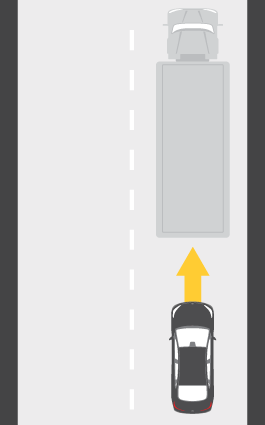Front crash prevention: vehicle-to-vehicle
The vehicle-to-vehicle front crash prevention test evaluates the effectiveness of forward collision warning and automatic emergency braking. The current version represents front-to-rear crash scenarios in which a vehicle approaches a passenger car, motorcycle or large truck that is stopped in the roadway from behind.



How the test is run
- A technician drives the test vehicle toward stationary targets designed to simulate the back of a passenger car and a motorcycle as well as an actual dry van trailer without touching the brake pedal.
- A GPS system, onboard camera and other sensors record when the forward collision warning alert occurs, how much the vehicle slows to avoid or mitigate a collision and other data.
- Multiple trials are conducted with each target at speeds of 31, 37 and 43 mph.
- At each speed, trials are conducted with the motorcycle or passenger car target positioned in the center of the travel lane and offset to the left or right.
- If the test vehicle fails to achieve a minimum speed reduction at the slower test speeds, only the forward collision warning system is evaluated in the higher-speed tests.
- The dry van trailer is always positioned in the center of the lane. Only the forward collision warning system is evaluated, and the driver steers out of the lane to avoid a crash.
How vehicles are evaluated
- Points are awarded for warnings that occur at least 2.1 seconds before the projected time of impact and for substantial speed reductions in the tests with the surrogate targets, based on the average achieved in three test runs.
- Speed reductions account for two-thirds and warnings account for one-third of the maximum possible score.
- In general, vehicles must issue timely warnings in all the scenarios and slow substantially or avoid a collision altogether in the braking tests to earn a good rating.
Vehicle front crash prevention test protocol and technical information
For details on other tests we conduct, visit the About our tests page.